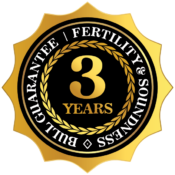Management & environmental issues
| Are the bulls from a TB accredited herd? | Yes |
| Have the bulls been tested for BVD and Vaccinated? | Yes |
| Have the bulls been checked for breeding soundness by a vet? | Yes |
| Have the bulls been service capacity or service capability tested? | Yes |
| On what class of country have the bulls been born and raised? | Medium/steep |
| Have the bulls been raised in a commercially focused farming environment? | Yes |
| What is the stocking rate on the farm? | 9.1 su/ha |
| Are yearling heifers mated? | Ye |
| What is the average in calf rate (including yearling heifers) for the herd? | 93% |
| For how many cycles are the cows/heifers exposed to the bull? | 2 |
| Does the herd have a history of good conformation and structural soundness? | Yes |
| What supplements have the bulls received? | Meadow hay |
| What type of bull guarantee does the breeder provide? | 3 years |
Genetic improvement issues
- What are the breeding objectives for the herd?
- Is the breeder recording with a recognized performance recording service provider (e.g. Breedplan, CSU)?
- Can the breeder provide evidence that genetic progress is being made in the traits in which you are interested i.e. by showing you a favourable genetic trends table?
- What is the average genetic merit of the breeder’s herd in relation to the breed average?
- Can the breeder supply you with percentile band information, enabling you to rank his bulls?
- Can the breeder supply you with $ Indexes (EBVs for Profit), which rank bulls according to their profitability, in different production systems?
- From where does the breeder source the herd sires and what are their EBVs/lndexes?
- What are the breeder’s main criteria for sire selection?
- Does the breeder mate yearlings – heifers and/or bulls?
- What proportion of bulls are sold in relation to the number born?
For your herd to improve, the breeder’s herd must have higher genetic merit and rate of improvement than yours.

